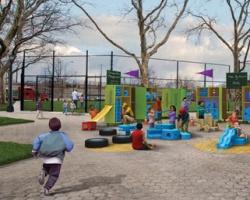When I was in fourth grade, my school replaced our playground. It had been a well-loved, ramshackle structure that seemed to rise 20 or 30 feet into the air. There was a rickety climbing wall made of old tires and a series of precarious metal bars. It was paradise. But when we returned to school after summer break one year, it was gone. In its place was something that looked as if it came out of a box: the standard American playground. The platforms were just a few safe feet from the ground, with a squat fireman’s pole and a covered plastic slide. There was also a molded plastic handle you could grip to slide from one platform to another, a mere foot off the mulch. Sliding got boring fast. So we climbed on top of it; then we fell off.
The replacement playground was distinctly less fun than the original. What I didn’t know then was that it was also distinctly worse: for me, for my imagination, for my problem-solving skills, just as its identical brethren were for developing kids everywhere. Indeed, playgrounds became safer and less inspired at a time when kids needed them most–when competition for children’s attention from video games and television meant that they provided the only outdoor playing time a child might get.




